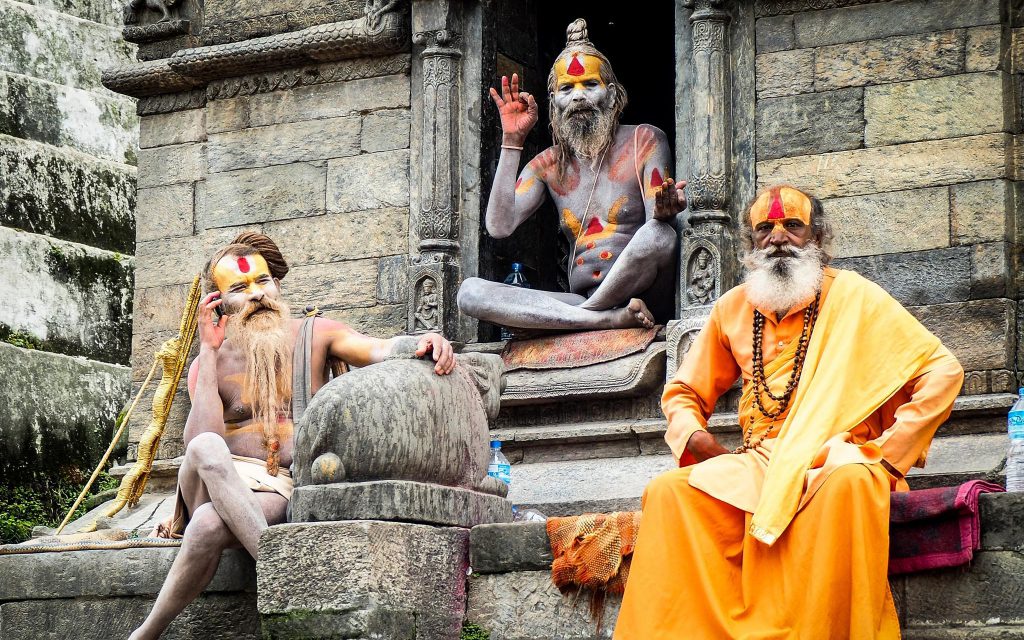
Jaimee Gallagher, aged 24, is a college athlete and a student working towards a degree in biology. Because she needs extra money for food and rent, Jaimee also works at a local breakfast restaurant. Jamie rarely has time for relaxation, let alone indulging in activities such as going out to the movies or out dancing. Recently Jamie’s favorite grandfather became ill, and she’s been trying to squeeze in time to spend with him, and to help take care of him. To say it lightly, Jaimee is stressed, and doesn’t have time to practice meditations or relaxation techniques that are time-consuming or difficult.
During track practice one day she heard her coach telling another student about Vedic meditation. The student was also enduring an intense amount of stress. Jaimee joined the conversation and learned that Vedic meditation can be practiced as much or as little as one wants, but it is like a super-charged version of meditation, because it uses a mantra or soothing sound to settle down the mind automatically. One doesn’t need to focus or use concentration, they merely have to say a mantra over and over again in their mind. This ability to keep the mind occupied basically skips a step in traditional forms of meditation that require that one empties the mind by sitting in complete silence. With Vedic meditation, the work is done for you, and you reap the benefits with as little as 20 to 40 minutes a day.
What is Vedic Meditation?
Vedic meditation is a form of meditation that focuses on a soothing affirmation or sound to distract the mind from what usually occupies it. Our minds are always focusing on something, even when we’re dreaming. Typically, we are focused on minute details that don’t really matter in the big picture. We think about so many things that are out of our control. We focus on the details of our day. We question how we’ll do on an exam in college, a presentation at work, or an assignment for a client. We question ourselves, our worth, our abilities, our looks, and we compare ourselves to others.

Many times, our thoughts are unhealthy, because they’re running on autopilot. Our thoughts loop on a pattern based on the psychology of our past. Our thoughts are a product of our deeply ingrained self-beliefs. This is why meditation is so important, and for people who have a hard time slowing down, Vedic meditation is a wonderful solution for giving our minds a break.
A wonderful analogy for thoughts functioning in our minds is to imagine a highway. Many cars are cruising along at high speeds on multiple lanes, and in opposite directions. For a highly distractive brain, the cars represent their thoughts. They’re moving so fast, even side by side, that an individual, half the time, can’t even comprehend what is going on in their own head! Beyond this, these thoughts are based on unconscious programs that are neurologically hardwired. In order to break these patterns and rewire our brains, we need to integrate meditation.

When we meditate, we’re slowing down our brainwaves. There are five brainwaves, which include (from fastest to slowest) Gamma, Beta, Alpha, Theta, and Delta.
Gamma is a very fast brainwave that is typically found in people who are having major epiphanies or are being flooded by creative ideas or processes. One could even say it’s a hyper state of awakening. This is a rare brainwave and can also be triggered by hallucinogens or psychotropic drugs.
Beta is the next slowest brainwave and it is the state in which most people exist in regular day to day exchanges and thought processes. This is where we communicate, cook dinner, clean the house, and use our brains to work, study, or perceive everyday reality.
The next slowest is Alpha, this is a state of relaxation that is a deep calm where thinking does not occur, or if it does, it’s typically like a drop in the ocean of consciousness, and brings clarity and wisdom. Theta is the slowest beyond Alpha where deep meditation and even REM and dreaming take place.
Delta is the slowest brainwave where our minds are “turned off” while our bodies are in the deepest stage of sleep. During Delta, the body repairs itself.
Theta, REM, and dreaming is the state where the mind processes what is happening in our lives, and works to make sense and bring repairs, and healing as well.
When we are using Vedic meditation, we are in Alpha. The Earth resonates somewhere between Alpha and Theta. Using Vedic meditation means that we are slowing down the frequency of our thoughts. In this sense, our brains are no longer functioning like speeding cars on a highway, instead it is like looking out at a sunset, or a beautiful forest, or the slow ebb and flow of the ocean on a calm summer day. The difference between other forms of meditation and Vedic is that we don’t have to actively halt our thinking, the mantras or sounds do it for you.
What are the Origins of Vedic Meditation?
Vedic is a term that began in ancient India. It refers to the “Vedas,” which were ancient Hindu texts written in Sanskrit. These books contained poems, hymns, and rituals. They were thought of as guides for priests and those wanting to learn and understand the secrets of Hinduism.

These Vedas were filled with wisdom and ancient philosophies, so in a sense, they were read to fill the mind with calm and soothing thoughts and ideas. Sanskrit is the ancient language of the Hindu people, and in Sanskrit the word veda means “revelation, science, truth, or knowledge.”
It is also said that the Vedas are arranged similarly to a staircase. Each step has more knowledge than the last step, but every step is leading towards the same goal of enlightenment. The whole process of taking in the wisdom from the Vedas is a subjective experience. Everyone will take their own time making their way up the staircase. Bits of knowledge are not laid out as you might read in a self-help book of today. The knowledge is rich and poetic, and you could even say it lies between the lines. Like the Veda texts, Vedic meditation works in a similar fashion. There is no straight rules or instructions on how to reach a state of internal bliss, this is something that will happen naturally and independently depending on the person. This kind of process already feels carefree and relaxing, doesn’t it? Just knowing that it’s not about the destination, it’s about the journey. It’s your journey, and there is no right or wrong way of going about it.
Who it is Vedic Meditation For?
Vedic meditation is for everyone! Especially those who live in our distraction-filled, busy, stressful society. This is because it can be practiced anywhere at any time. While closing your eyes and getting comfortable in a quiet room at home might make it easier, you can use mantras while standing in line at the store, riding on the bus, or walking to or from your destination. It is simple and easy, and where some forms of meditation require doing something, Vedic meditation requires that you don’t do anything other than say a mantra over and over again.

We are no longer living close to nature. We no longer hear the sound of natural animals in their natural habitat. We rarely see wildlife other than squirrels, bugs, and birds. We live in a world with superficial distractions, obsession with entertainment, and a media drenched in negativity. It is no longer simple enough to get away from the tribe to walk along the river or commune with the sky or nature. Now it can take hours to find our way to an empty beach, forest, or hiking trail. We do not have time to do this in a world where working forty hours a week is the norm. We have families to raise, friendships to maintain, hobbies and dreams to work on in our spare time, and for most of us—we need at least eight hours of sleep. Relaxation nowadays means turning on the TV.
Vedic meditation is for those individuals who are looking for more; a spiritual connection, divine guidance, or just simply a drug-free way to relieve stress, anxiety, or depression. It is for those people who live a hard-working life, who are going after their goals, and who spend time helping others. Mostly, however, Vedic meditation is for those beautiful people in the world who deserve to take a break from the constant barrage of the external world, and to give themselves permission to bask in self-love, and to fill themselves up with positive energy.
What are the Benefits of Vedic Meditation?
The benefits of Vedic meditation are many. Science is now telling us that we can rewire the brain with something called neuroplasticity. This is a process that changes core self-beliefs through meditation or other meditative techniques used in psychotherapy and by cognitive practitioners. Rewiring the brain actually changes our DNA. This means that hereditary diseases or ailments can be eliminated by using Vedic meditation.

Using Vedic meditation helps you sleep without having to use toxic or habit-forming medications, it can alleviate anxiety, stress, and depression, and it can make you actually look forward to working out! Using mantras or affirmations while working out can increase serotonin levels and self-confidence.
Cortisol is the major stress hormone, and it is connected to our reproductive hormones, which are connected to the skin. Acne is more common in adults today than ever before! Using Vedic meditation can help decrease stress, which will in turn decrease acne, eczema, psoriasis, or any other skin problems. Other stress hormones in the brain such as epinephrine is actually released as adrenaline. When our bodies are in a constant state of adrenal stress, we’re constantly releasing cortisol. In this society, we are so stressed that our bodies can run and run on adrenaline without stopping, even to the point of affecting our immune system, which causes us to get sick more often. This is especially true for individuals who have Post-Traumatic Stress or endured childhood trauma. In indigenous times this would be the equivalent of running from a tiger or jaguar all the time.
Additionally, Vedic meditation helps you tap into your creative side and your imagination. It helps you become more present and to live in the moment. It helps heal past pain or trauma, allowing you to have control over your emotions so that you do not react unconsciously to stressful situations or relationships.
Vedic meditation will increase your ability to concentrate and understand complex theories or concepts. You will find that you have more energy than before, and that you don’t need to turn to that five o’clock glass of wine to unwind from a hectic day. You will attract better relationships and in general, have a more grateful and compassionate perspective on life.
How Does One Do Vedic Meditation?
Find a quiet place to sit if you can, if not, as mentioned earlier you can practice Vedic meditation anywhere you wish. Try to make sure your spine and back are supported.
Take in a few deep breaths and begin to recite your mantra. The mantra that is specific to you will require the help of a guru, or some research. You will want to use Sanskrit words, and can use the word in a chant or sing-song way in your mind.
A term that you are likely familiar with is “Om,” which relates to the celestial sound of the universe. Before beginning your yoga practice (which also stems from the Vedas), it is customary to say the word “Om” three times, holding it out as long as your breath exhales, sort of like the sound of a bell being tapped three times.

In Vedic meditation, different vowels are pronounced and elongated in different ways. If you are unsure what word to use as a mantra, check out our Mindbliss App, download the app by clicking HERE from your iPhone or Android. We have so many wonderful Mantra based meditations for your enjoyment 🙂
At Mindbliss we have a large and diverse range of 300 (and growing) quality meditations. We are always hard at work curating the best ones for you. 🙂 We hope you love them. 💜
Let us know how these mantra based meditations worked for you, we would love to hear about how meditation has impacted your life 🙂
With Love,
The Mindbliss Team.

